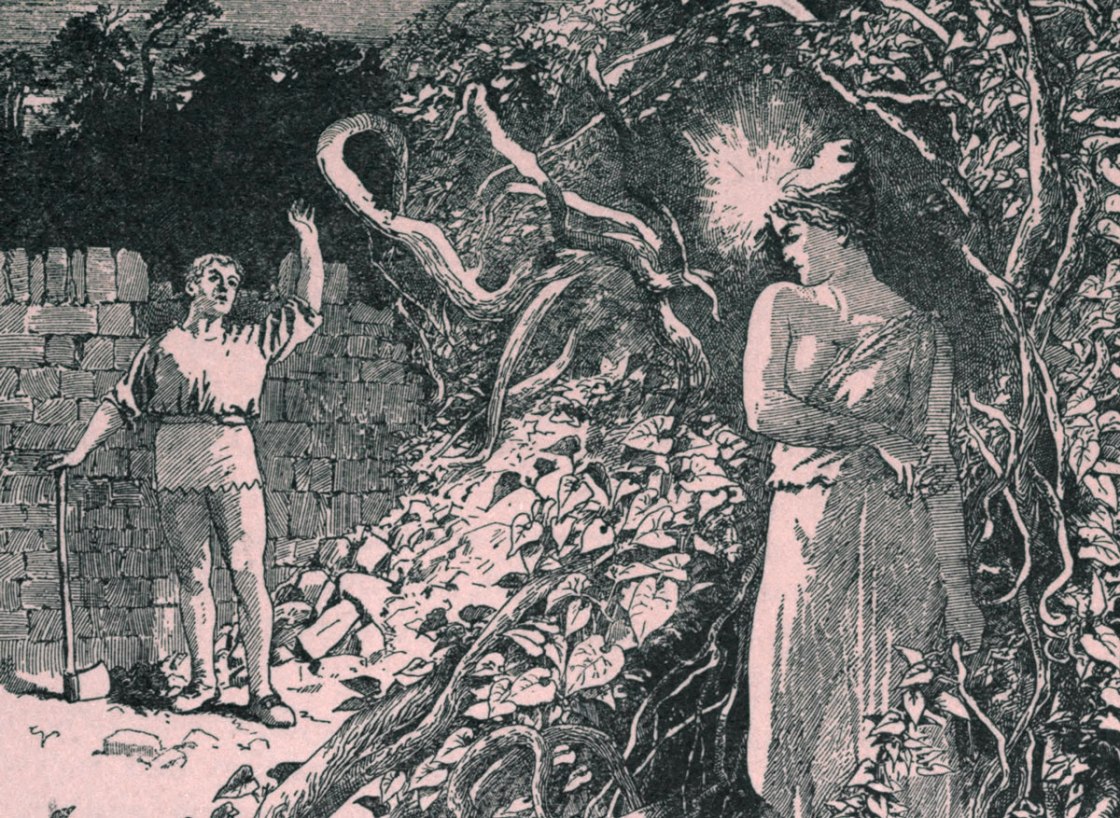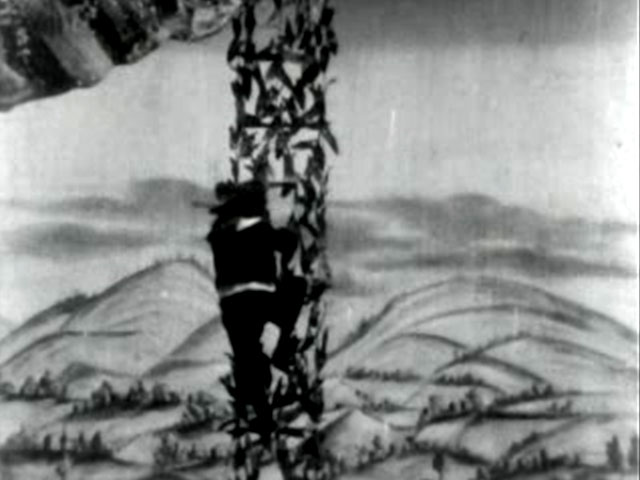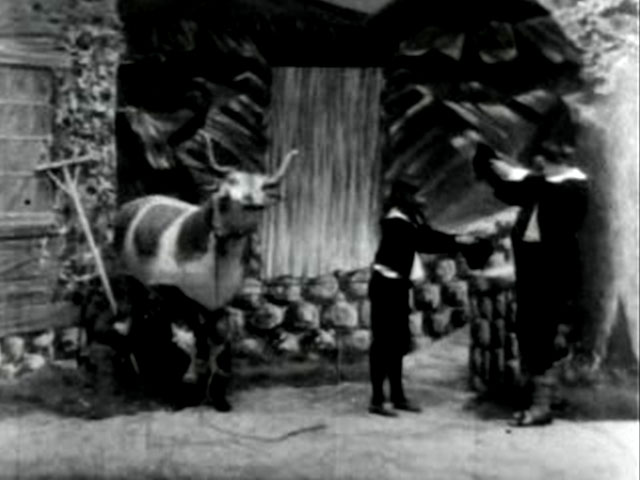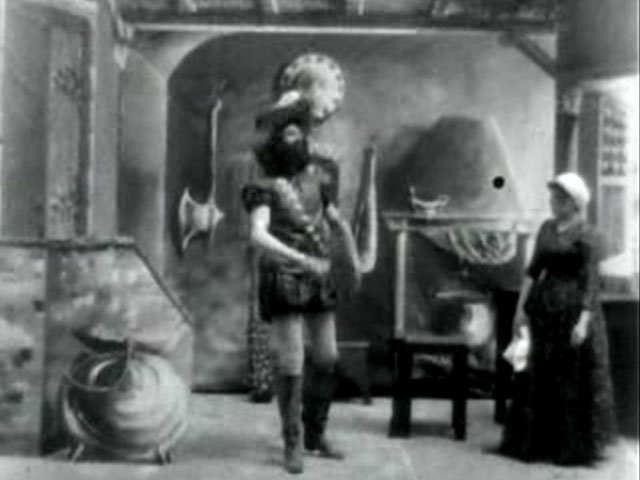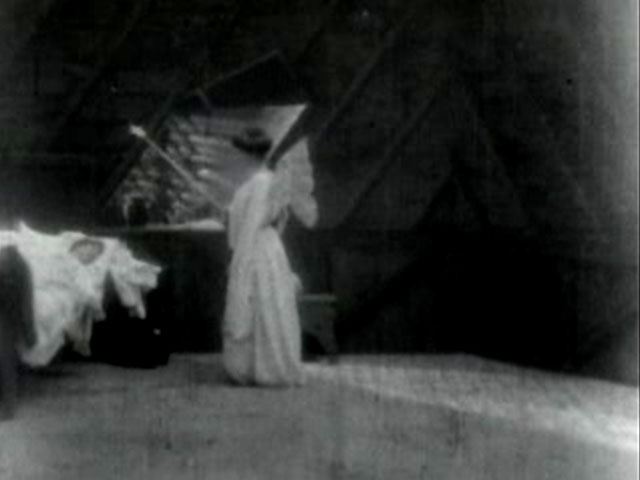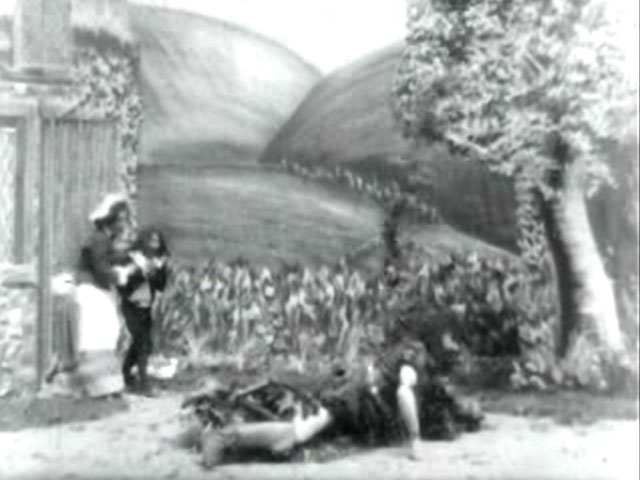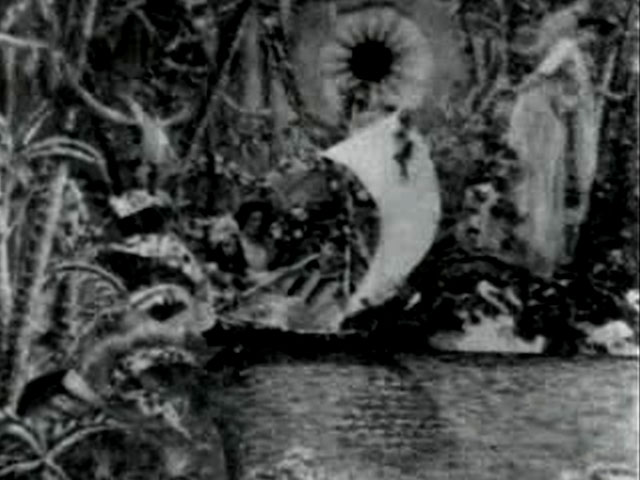A kid named Jack, some magic beans, a beanstalk… you know the drill. This was an early film from Edwin S. Porter that attempted to rival the popular French fairy tale productions. There is also a pantomime cow.
Home Media Availability: Stream from the Library of Congress.
Hill of beans
Edwin S. Porter was one of the great innovators of the early American film industry but, despite The Great Train Robbery being featured in just about every early film retrospective, his own personal modesty assured obscurity in an industry that revolves around narcissism.
Jack and the Beanstalk was one of Porter’s early pictures as a director at the Edison film company (in collaboration with Arthur White) and while it clearly took some notes from earlier fairy tale films (and likely the wildly popular fairy tale stage extravaganzas, as well as magic lantern slide collections), Porter had a few tricks up his sleeve. Porter stated that the production took six weeks during the spring of 1902. It was certainly one of the longest narrative films released to date at a whopping ten minutes and change.
The story opens with a fairy appearing and giving magic beans to a random man on the street. Soon, Jack comes along with his cow (two guys in a cow suit) and is persuaded to swap while the pantomime bovine capers and prances.
The hammy cow may seem out of place given the fact that most written versions of the story do not place particular emphasis on the animal but at the time, Jack and the Beanstalk was a popular stage property. A January 1902 San Francisco production caused a sensation and the actors portraying the cow were singled out for praise. So, there was definite stage precedent.
Anyway, Jack’s mother throws away the beans and sends him to bed but the fairy appears in the night and shows him a vision of a giant beanstalk with treasures spilling out of it. This scene is interesting because the fairy appears and disappears using an abrupt substitution splice, while the beanstalk vision appears via dreamy dissolve.
Jack awakens, finds the giant beanstalk, climbs it awkwardly and then is shown a vision of the giant’s castle by the fairy. (Porter uses an intentionally unfocused lens to create a third type of transition for this sequence.) Thus, our hero heads off for his inevitable run-in with the giant.
Jack and the Beanstalk is fascinating because it showcases the ambition of Porter while he was still learning the ropes of trick films. The film’s main claim to fame, beyond its ambitious multi-scene story, was the use of dissolves to create a gentler transition between scenes.
The dissolves proved to be a selling point for the picture, as shown by this description in the Edison catalog: “In this beautiful production, in changing from one scene to the other, transformations are made by beautiful dissolving and fading effects. There are no sudden jumps whatever, and the entire effect is at once pleasing, gratifying and comprehensive, and the audience finds itself following with ease the thread of this most wonderful of all fairy tales.”
(That’s not to say Porter invented the dissolve or that this was the first time he used a dissolve to transition between scenes. Industry hoopla is never to be trusted. However, it is safe to say that this was an early use of dissolves between shots and a successful one.)
There were some mistakes in the production. The pantomime cow knocks over a prop rake while performing its jaunty dance and Jack’s mother just cannot get the door to her house closed when she drags her naughty son inside. It’s likely that the dissolves—achieved in-camera—made retakes quite undesirable.
Much of the film’s magic was derived from established stage techniques. The watermill’s “water” is made of fabric, the beanstalk is raised and lowered with wires, the objects in Jack’s vision come to life thanks to puppetry. However, this is hardly a filmed play and the use of special effects show that Porter understood movies needed a little extra oomph.
Now, any adaptation of Jack and the Beanstalk has a few moral decisions with which to wrangle. In its original form, the story is basically “Jack finds a new land with good things. He kills the owner and takes these things.” Now, of course, this would absolutely never do for a European children’s story. It would do just fine for European foreign policy but not for a children’s story.
So, many later versions of the tale make it clear that the giant has stolen these items, often from Jack’s family, and Jack is merely taking back what is his. In fact, he is not a poor farmer’s son at all but an aristocrat. Of course, a major issue with these rewrites is that the local peasantry will now be ruled by someone silly enough to trade a cow for beans. That will do for European domestic policy but not for a children’s story.
The Porter version of Jack and the Beanstalk not only includes the plot twist that Jack was the prince whom the giant robbed (though he didn’t know this when he went on his robbery and killing spree) but shows him being guided throughout the film by a good fairy. The fairy’s narrative purpose seems to be to drag Jack kicking and screaming up that beanstalk instead of just handing him the beans herself and telling him about his past. However, I won’t split too many hairs as the main purpose of the fairy in the film was to showcase splices.
The idea of a magic kingdom just a beanstalk away has lodged itself in the imaginations of movie executives, if not the public at large. The was proven by the 2013 big screen adaptation Jack the Giant Slayer, which combined two fairy tale Jacks, attempted to tell a dark “realistic” version of the story and was granted a whopping $200 million budget. The film landed with a bigger thud than the giant and racked up losses into the hundreds of millions.
Well, obviously. Pantomime cows over CGI giants any day of the week.
One more quick note: It’s easy to say that any fairy tale film was a Méliès ripoff but it’s important to remember how popular and widespread fairy tales were in the popular media of the time. Porter did project Méliès films and it’s easy to see that he was influenced (the final tableau in Jack and the Beanstalk, for example) but it’s also important to know that many early filmmakers were simply drawing from the same well of influences.
Further, we are seeing just a fraction of the film’s original wonders. The surviving film is derived from a paper print deposited at the Library of Congress for copyright purposes. Further, the original release of the film was available in a wide variety of color combinations. The basic cost of a plain black and white print was $93.75 (approximately $3,000) but Edison also sold a simple color version with the characters and beanstalk painted by hand for an additional $85 and an elaborate colored version with all backgrounds and details tinted for an additional $140. Colored films were a major draw and the fancier print would have been money well spent.
(You can read more about this in Moving Color: Early Film, Mass Culture, Modernism by Joshua Yumibe. You can see an example of Edison color in The Great Train Robbery and Annabelle’s Serpentine Dance.)
Jack and the Beanstalk is not as polished as French fairy tale productions made at the same time. However, the stage effects and slight prop mishaps add to the charm of this early Porter film and make his evolution in films like The Great Train Robbery and Dream of a Rarebit Fiend all the more impressive.
Where can I see it?
Available for free viewing courtesy of the Library of Congress and included in the Edison: The Invention of the Movies box set from Kino.
☙❦❧
Like what you’re reading? Please consider sponsoring me on Patreon. All patrons will get early previews of upcoming features, exclusive polls and other goodies.
Disclosure: Some links included in this post may be affiliate links to products sold by Amazon and as an Amazon Associate I earn from qualifying purchases.
